Sarbi
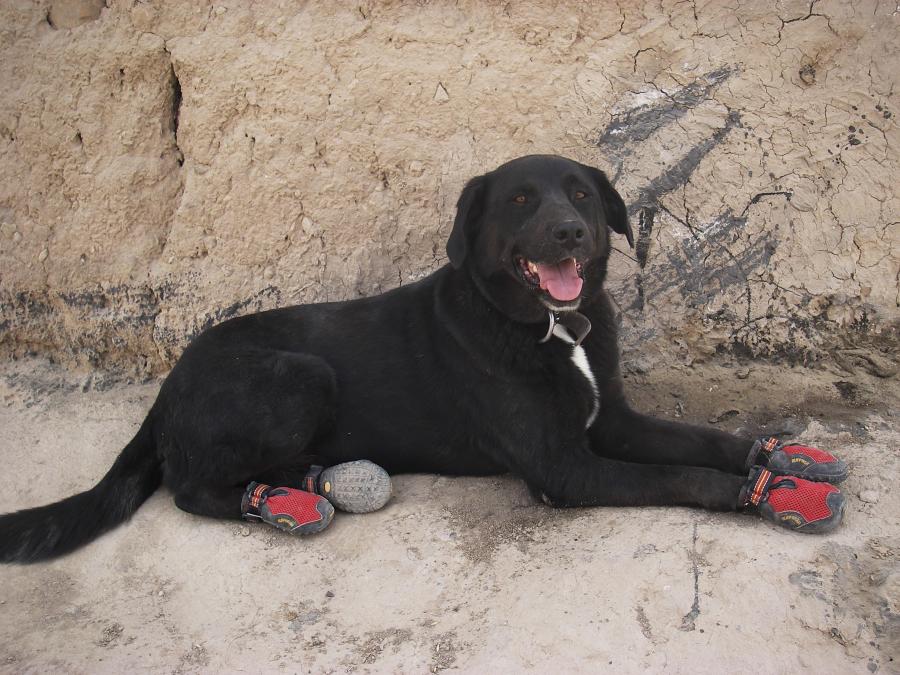
Explosive Detection Dog Sarbi rests during a patrol near Tarin Kot, Afghanistan, 2007. (Image courtesy Department of Defence, AWM2016.427.4)
In mid-2005, two black Labrador-Newfoundland-cross dogs were adopted by Corporal Murray Young from the Australian Army. He was looking for dogs aged between 18 months and three years of age to join the Explosive Detection Dog (EDD) Section. The dogs were named Rafiki (Rafi) and Sarabi (Sarbi), after characters from the Disney movie The Lion King (1994). While Rafi loved to swim, Sarbi was obsessed with chasing and retrieving balls.
Rafi and Sarbi undertook intensive training. They learnt to identify various explosive materials, and how to cope with the loud noises of war. Rafi was attached to Murray, while Sarbi’s handler was Corporal David Simpson.
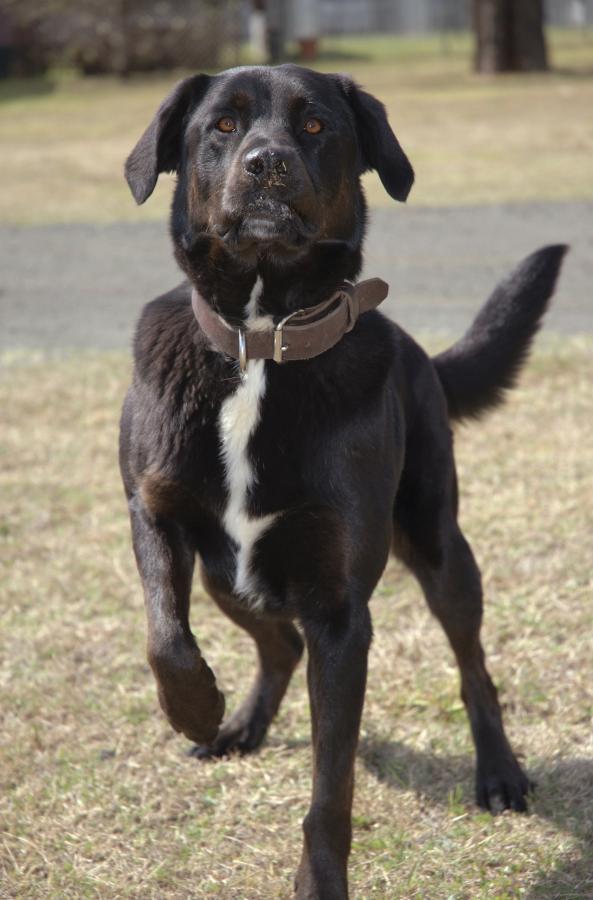
Sarbi during her training at the School of Military Engineering in Moorebank, Sydney, in 2006. (Image courtesy of the Department of Defence, 2006adfSME_001)
When Sarbi found dangerous materials, David would throw her a tennis ball as a reward. Sarbi responded to the task like it was a game. After the dogs graduated in November 2005, Rafi and Murray were posted to Townsville, while Sarbi and David went to Sydney.
In 2007 Sarbi and David travelled to Afghanistan for a seven-month deployment with the Australian Army. Afghanistan experienced extreme weather, from freezing cold winters to incredibly hot summers. The team had to be prepared for all conditions, with Sarbi receiving protective eyewear called “doggles”, booties to protect her paws from sharp rocks and prickles, and custom headphones to protect her ears from weapons fire.
Sarbi and David went on a second tour to Afghanistan in June 2008, working with Special Air Service Regiment (SASR) and commando units to remove the Taliban and insurgent leaders.
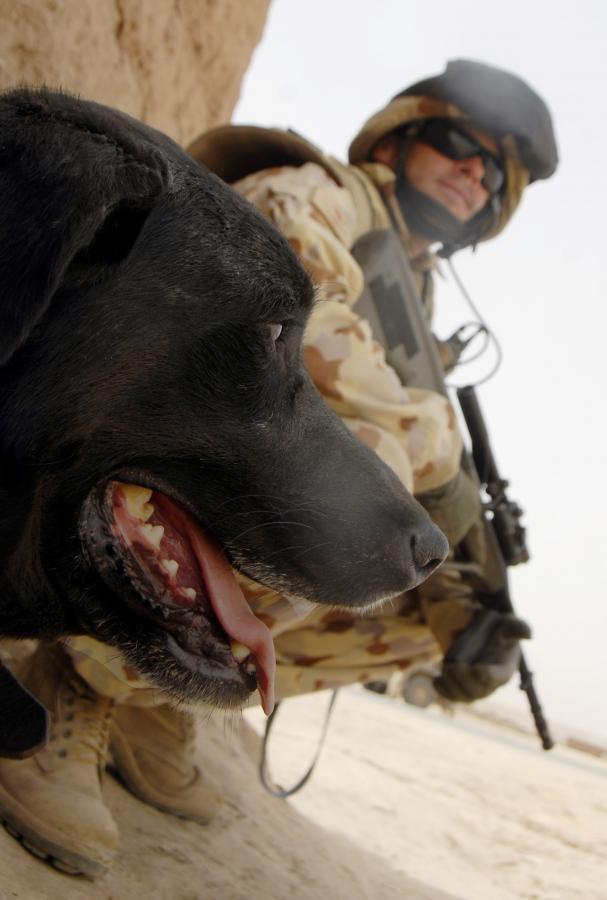
Sarbi with David in Afghanistan, 2007. (Hayden Barlow, image courtesy of the Department of Defence, 20070723adf8255272_078)
On 2 September 2008, Sarbi and David were operating in Afghanistan with the SASR, United States Special Forces, and the Afghan National Army (ANA). Sarbi had a canine friend on board named Jacko, who was with his US handler, Sergeant First Class Gregory Rodriguez. The convoy was returning to forward operating base Anaconda in Khas Uruzgan when it was attacked by enemy fighters who were hiding in the surrounding mountains and farming areas. Amid the explosions, David and many of the other soldiers jumped out of their vehicles, using them as cover as they returned fire. The convoy kept moving forward, but the enemy moved with it.
Shrapnel from an exploding rocket propelled grenade (RPG) hit David in the leg and broke the clip that attached Sarbi’s lead to his hip. Sarbi continued to run alongside the vehicles despite being wounded by shrapnel.
At one point David climbed up on the Humvee to operate the heavy machine-gun. An RPG hit under the vehicle, and he and an Afghan interpreter were blown off the truck. David had also been hit by a bullet that had deflected off a vehicle into his hip, and had wounds across his arms and chest. He took cover in a ditch, and called out for Sarbi, who came within a few metres of him before being startled by gun-fire; she turned and fled.
“That,” said David, “was the last time I saw Sarbi.”[1]
By the time the convoy made it through to safety, the ambush had lasted three hours and moved just four kilometres. Nine of the 12 Australians on board were wounded. American dog handler Gregory Rodriguez was killed in the ambush. His dog, Jacko, later retired and was adopted by Rodriguez’s family. Sarbi was listed as “missing in action”.
David was flown to hospital for surgery, and returned to Australia in November 2008. Knowing that Sarbi had gone missing when temperatures were about to plummet had made leaving difficult. He asked his friends in the SASR and US Special Forces to look out for her, believing that she would try to make her way back. They left some of David’s sweaty clothes out around the perimeter fence to help her pick up his scent. An Australian military official reported that Sarbi had returned to the base, but that Afghan guards had shooed her away.[2] At one point an Australian Intelligence Officer was monitoring telephone conversations when they heard the Taliban talking about a dog, trying to decide what to do with it. During one phone call, it was apparent that the dog was causing trouble and getting into the chickens. The Australians and Americans wondered if this dog could be Sarbi.
Intelligence reports later confirmed that Sarbi was with local Taliban commander and village elder Mullah Hamdullah. Coalition forces tried to arrange a trade, offering to release the mullah’s father from prison if Sarbi was returned, but the deal was rejected. Special Forces wanted to go and get Sarbi, but the risks were too high. Eventually, the mullah agreed to sell Sarbi to the coalition forces.
In October 2009, almost 13 months after Sarbi went missing, David was working at the School of Military Engineering in Sydney when he received a call from Corporal Murray Young,
“Mate, we think we’ve got Sarbi.”[3]
Sarbi was returned, and appeared to be healthy and excited to be there. Her understanding of English commands, desire to play with a ball, and microchip identification provided evidence that she was Sarbi.
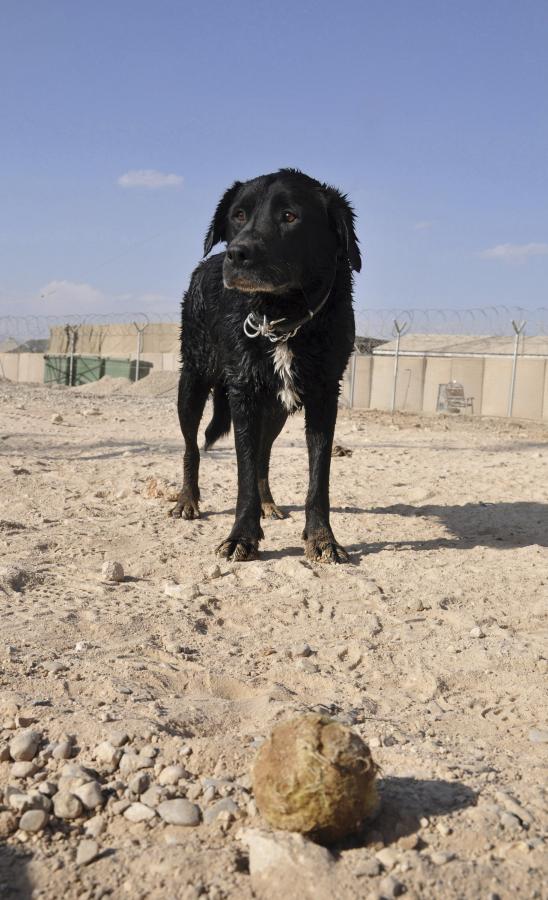
A freshly bathed Sarbi following her discovery and return to the Australian Base at Tarin Kot on 28 October 2009. (Stuart Wood,image courtesy of the Department of Defence, 20091028adf8251931_055)
Sarbi was put on a Chinook helicopter and flown to Camp Russell at Tarin Kot. Murray recognised her instantly, even though her fur was a little grey around the muzzle and she had put on a little weight. Sarbi had a full check-up and was given a bath. The men and women at Camp Russell gave her a hero’s welcome, and presented her with a box of tennis balls. As news spread of Sarbi’s miraculous survival, she started receiving fan mail from around the world.
The famous dog spent six months in the United Arab Emirates for mandatory quarantine before returning home on 10 December 2010, more than two years after she went missing.
Sarbi was awarded the War Dog Operational Medal with Afghanistan Clasp, and the Canine Service Medal for five years of service. Rafi was also awarded these medals for his service in Afghanistan, but died in 2009 after he was bitten by a snake in Townsville.
In 2011 Sarbi attended a special ceremony at the Australian War Memorial where she was awarded an RSPCA Australia medal, the Purple Cross. A crowd of people watched as she was recognised for her service to humans, and for her exceptional courage. Sarbi is the second animal to be awarded this medal for service in wartime, after one of Simpson’s donkeys was recognised in 1997.
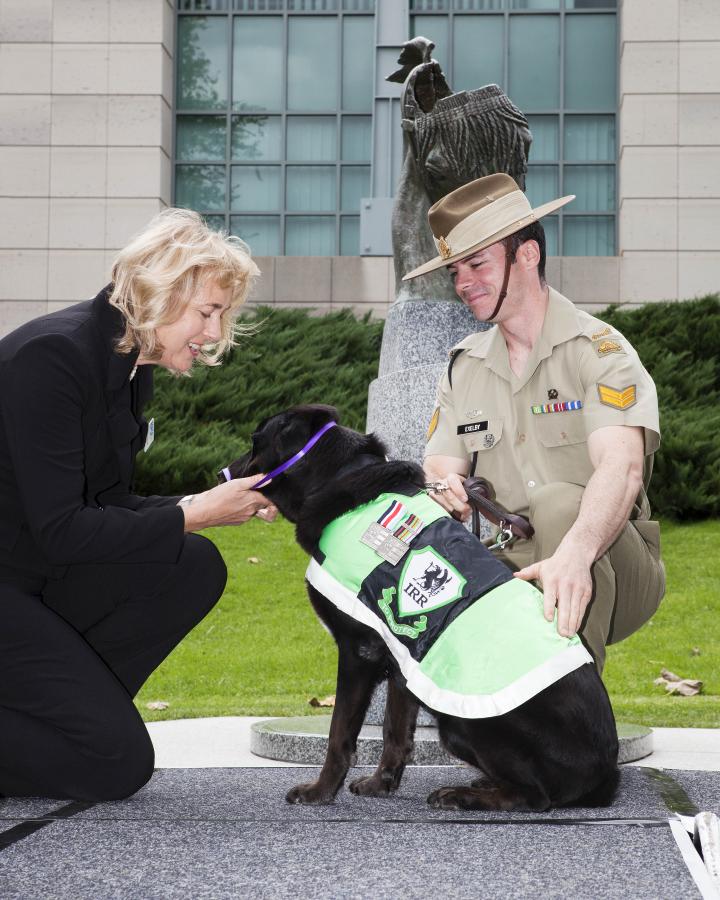
RSPCA National President Lynne Bradshaw presents Sarbi with the Purple Cross in 2011. She is accompanied by Corporal Adam Exelby. Sarbi is wearing her ceremonial jacket of the Incident Response Regiment, whose motto is “To protect”. (Steve Burton, AWM PAIU2011/025.01)
When it was time for Sarbi to retire, she went to live with David, his partner, and one of David’s retired EDDs Vegas. Vegas passed away in 2014 at the age of 16, and Sarbi died the following year, aged 12, after a short battle with cancer. People around Australia mourned her loss, and David posted the following message on Facebook:
Sarbi will live on in everyone’s hearts and minds and I hope that her story of perseverance and determination will inspire you to do whatever you can to achieve your goals and dreams.[4]
Rachel Potter, Explosive Detection Dog Sarbi, 2013, watercolour on paper.
Activities
- Sarbi was an Explosive Detection Dog.
- Research other roles that dogs have played in times of war.
- Sarbi was given boots to protect her feet, doggles to protect her eyes, and headphones to protect her ears. She was also given a special jacket during cold weather. Draw a picture of Sarbi wearing her protective gear.
- You can view the ceremony where Sarbi was presented with her Purple Cross on YouTube. Research other animals that have been awarded medals in times of war.
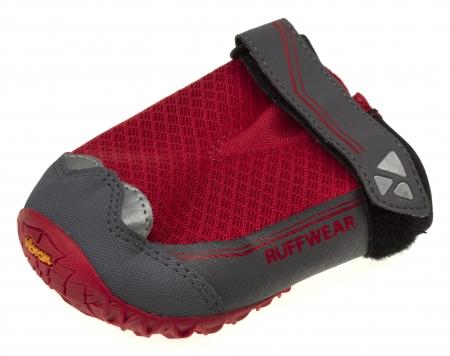
Boots such as this are worn by service dogs on deployment to protect their paws from harsh environments.
- In 2015 a sculpture dedicated to Explosive Detection Dogs and their handlers was unveiled at the Australian War Memorial. You can read more about the sculpture, Elevation of the senses on the Memorial's website.
- Why do you think the soldier and dog have been positioned at eye-level to each other?
- Can you find the tennis ball in the sculpture?
- Why do you think dog handlers would use a tennis ball as a reward instead of food when they are on deployment?
- Investigate the symbolism of the purple poppy
- In 2015 a park north of Brisbane opened in honour of Sarbi. Named “Sarbi Park”, the grounds include a playground, exercise equipment, barbecues, and an off-leash dog area. Design your own park commemorating the service and sacrifice of dogs in wartime.
- Extension: When Sarbi went missing, David and an Afghan interpreter were thrown off their vehicle. Although David was able to move to a covered position, the Afghan interpreter was badly injured. Trooper Mark Donaldson ran to his aid across exposed ground. Research Mark Donaldson and the medal that he was awarded for his actions that day. The following article on Trooper Mark Donaldson VC may assist.
Related objects
Footnotes
[1] Sandra Lee, Saving Private Sarbi, Allen & Unwin, New South Wales, 2011, p. 216
[2] Lee, Saving Private Sarbi, p. 224.
[3] Lee, Saving Private Sarbi, p. 231.
[4] Cassie Crofts, “Australia’s war hero dog”, National Geographic, 18 July 2016, <accessed 2 October 2019>.
Bibliography
Cameron Atfield, “Canine war hero Sarbi visits Brisbane dog park named in her honour”, Sydney Morning Herald, <accessed 26 September 2019>.
Cassie Crofts, “Australia’s war hero dog”, National Geographic, 18 July 2016, <accessed 2 October 2019>.
Louise Maher, “Sarbi the much-loved bomb sniffer dog preserved forever at Australian War Memorial”, ABC, <accessed 26 September 2019>.
Patrick Hatch, “Australian war hero dog Sarbi dies, aged 12”, Sydney Morning Herald, <accessed 26 September 2019>.
Sandra Lee, Saving Private Sarbi, Allen & Unwin, New South Wales, 2011.

